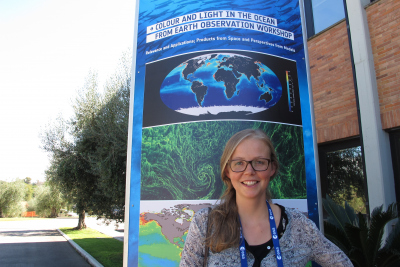Die Inhalte dieser Seite sind leider nicht auf Deutsch verfügbar.
Seitenpfad:
Julia Oelker
Report of GLOMAR PhD student Julia Oelker about her participation in the Colour and light in the ocean from earth observations workshop in Rome, Italy from 6 - 8 September 2016
The "Colour and light in the ocean from earth observations" (CLEO) workshop took place at the European space research institute of the European space agency (ESA-ESRIN) in Frascati, a beautiful small town surrounded by vineyards and overlooking Rome. It was organized by the principle investigators of ocean color projects funded by ESA and divided into 5 topic sessions dealing with ocean-color applications for climate studies, light field in the ocean, non-chlorophyll components of ocean optics, phytoplankton diversity, and carbon pools.
In my PhD, I am studying the phytoplankton diversity using hyper-spectral satellite sensors, i.e., sensors that record spectra with spectral resolution of 0.5 nm, in contrast to classical multi-spectral ocean color sensors that have around 8 wavelength bands. Since the CLEO topics directly match my research interest, I was very eager to attend especially the sessions on light field and phytoplankton diversity. As it turned out, the two most interesting sessions for me were the sessions on applications for climate studies and phytoplankton diversity.
In the phytoplankton diversity session, I presented my recent phytoplankton type study comparing results from two different hyper-spectral sensors in a talk with the title "Towards improved spatial resolution of hyper-spectral phytoplankton functional type products". As the title suggests, I talked about the advances in hyper-spectral sensors that can be exploited for ocean color applications, all in preparation for the new TROPOMI sensor that is part of ESA‘s sentinel missions. Since this upcoming sensor has comparable spatial resolution to that of the OC-CCI product (a merged phytoplankton product from several multi-spectral ocean color sensors), we received good resonance for planning to use this sensor for phytoplankton type retrievals.
CLEO offered great opportunity for networking. Since it was exclusively organized by and for the ocean color community, a majority of the leading European experts in this field participated. With a size of 160 participants and no parallel sessions, I found it rather easy to find the time to approach the senior scientists because nobody was busy running off to the next session.
Part of the time was dedicated to discussions addressing the question how ESA can support the community in reaching their scientific goals with respect to, e.g., user need, technical infrastructure, and upcoming satellite missions. Following these discussions, a roadmap will be handed in to ESA. It was very interesting to experience how such discussions take place and what the future strategy looks like. The atmosphere was in general very friendly and supportive.
I would like to thank GLOMAR for supporting me financially and with that giving me the chance to enhance the visibility of my own scientific work, increase my knowledge in the field, connect to other ocean color scientists, and get insight into strategy planning.
In my PhD, I am studying the phytoplankton diversity using hyper-spectral satellite sensors, i.e., sensors that record spectra with spectral resolution of 0.5 nm, in contrast to classical multi-spectral ocean color sensors that have around 8 wavelength bands. Since the CLEO topics directly match my research interest, I was very eager to attend especially the sessions on light field and phytoplankton diversity. As it turned out, the two most interesting sessions for me were the sessions on applications for climate studies and phytoplankton diversity.
In the phytoplankton diversity session, I presented my recent phytoplankton type study comparing results from two different hyper-spectral sensors in a talk with the title "Towards improved spatial resolution of hyper-spectral phytoplankton functional type products". As the title suggests, I talked about the advances in hyper-spectral sensors that can be exploited for ocean color applications, all in preparation for the new TROPOMI sensor that is part of ESA‘s sentinel missions. Since this upcoming sensor has comparable spatial resolution to that of the OC-CCI product (a merged phytoplankton product from several multi-spectral ocean color sensors), we received good resonance for planning to use this sensor for phytoplankton type retrievals.
CLEO offered great opportunity for networking. Since it was exclusively organized by and for the ocean color community, a majority of the leading European experts in this field participated. With a size of 160 participants and no parallel sessions, I found it rather easy to find the time to approach the senior scientists because nobody was busy running off to the next session.
Part of the time was dedicated to discussions addressing the question how ESA can support the community in reaching their scientific goals with respect to, e.g., user need, technical infrastructure, and upcoming satellite missions. Following these discussions, a roadmap will be handed in to ESA. It was very interesting to experience how such discussions take place and what the future strategy looks like. The atmosphere was in general very friendly and supportive.
I would like to thank GLOMAR for supporting me financially and with that giving me the chance to enhance the visibility of my own scientific work, increase my knowledge in the field, connect to other ocean color scientists, and get insight into strategy planning.



